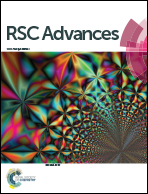Synthesis optimization of the ultra-microporous [Ni3(HCOO)6] framework to improve its CH4/N2 separation selectivity†
Abstract
Separation of methane and nitrogen is an important issue in upgrading low-quality natural gas, and non-cryogenic, adsorption-based separation of CH4/N2 is particularly challenging. In this report, a metal–organic framework (MOF) adsorbent, namely a [Ni3(HCOO)6] framework, is comprehensively investigated for the separation of CH4–N2 mixture via pure gas adsorption and binary gas breakthrough experiments. All the prepared samples synthesized using different routes were also studied in detail by powder XRD, FT-IR, SEM, TGA/DSC and argon adsorption. The results show that the adsorptive separation performances can be improved significantly by optimizing the synthesis of the framework. The precursors play crucial roles in the crystallization of [Ni3(HCOO)6] frameworks, giving rise to a variability in ultra-micropore volume, surface area and pore size. Good crystallization can result in large ultra-micropore volume and furthermore brings about high separation selectivity. The [Ni3(HCOO)6] framework synthesized from nickel nitrate and methyl formate exhibits the best crystallization and the largest micropore volume, leading to the highest CH4/N2 separation selectivity of up to 7.5 in the pressure range of 2.0–10 bar, which is the highest value reported for MOFs. Moreover, this adsorbent presents uniform nanosized crystals (∼140 nm), permanent porosity and consistent separation performances, making the [Ni3(HCOO)6] framework a promising candidate for natural gas upgrading.
![Graphical abstract: Synthesis optimization of the ultra-microporous [Ni3(HCOO)6] framework to improve its CH4/N2 separation selectivity](/en/Image/Get?imageInfo.ImageType=GA&imageInfo.ImageIdentifier.ManuscriptID=C4RA05407E&imageInfo.ImageIdentifier.Year=2014)

 Please wait while we load your content...
Please wait while we load your content...